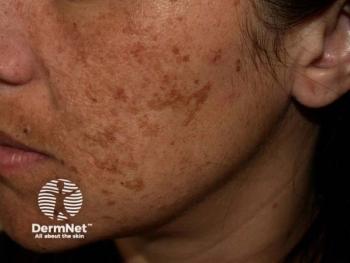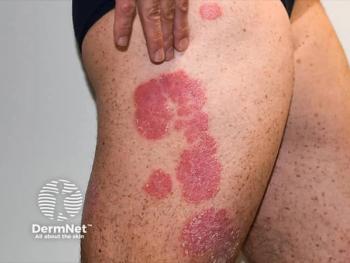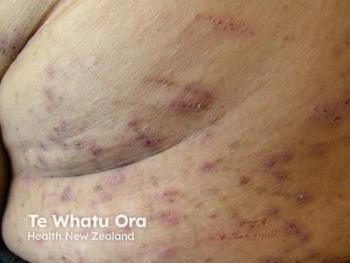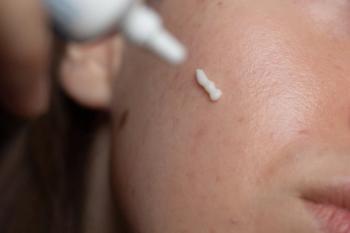
Top 5 Articles of the Week: June 29-July 4
Key Takeaways
- Ritlecitinib shows promise for alopecia areata, with 46% achieving complete regrowth and 93.1% maintaining results over two years.
- Chronic urticaria significantly increases the likelihood of psychiatric comorbidities, with strong links to stress and dysthymia.
Explore the top headlines of the week, including insights on the latest clinical trials, therapeutic updates, and more.
To stay up to date with the latest dermatology news, sign up to receive our
1. Nearly Half of Patients Respond to Ritlecitinib for Alopecia Areata, With Most Sustaining Results
A recent analysis of the ALLEGRO and ALLEGRO-LT trials found that nearly half of patients with moderate to severe alopecia areata treated with ritlecitinib (Litfulo) achieved significant scalp hair regrowth, with 46% of responders achieving complete regrowth and 93.1% maintaining it over 2 years. Clinical response was more likely among younger, predominantly female patients with milder baseline disease and shorter disease duration, whereas older age, male sex, and extensive or prolonged hair loss predicted poorer outcomes.
2. Chronic Urticaria Is Linked to Increased Odds of Psychiatric Comorbidity
A recent case-controlled study published in the Journal of the European Academy of Dermatology and Venereology found that individuals with chronic urticaria are significantly more likely to develop psychiatric comorbidities, including anxiety, depression, insomnia, attention-deficit/hyperactivity disorder, posttraumatic stress disorder, and substance use disorder, compared with controls. The strongest associations were seen with psychological stress and dysthymia, with odds ratios exceeding 3 for most conditions.
3. What’s Shaping the Future of Alopecia Treatment, According to Leading Clinicians
Hair loss was a front-and-center theme at the 2025 Society of Dermatology Physician Associates Summer Dermatology Conference in Washington, DC, where several key opinion leaders and experts shared practical, evidence-based approaches for managing and treating alopecia areata, scarring alopecias, and nonscarring hair loss.
Across several sessions, dermatology clinicians received a tool kit of diagnostic and therapeutic insights, from the evolving role of Janus kinase inhibitors to the diagnostic power of trichoscopy and the hidden role of allergic triggers. We've compiled a list of the top 3 takeaways from talks on hair loss.
4. Q&A: Jonathan Bernstein, MD, FAAAAI, Discusses Advances in Chronic Spontaneous Urticaria Treatments and AAAAI Data
At the 2025 American Academy of Allergy, Asthma, and Immunology (AAAAI)/World Allergy Organization Joint Congress, Jonathan Bernstein, MD, FAAAAI, presented multiple abstracts on the efficacy of rilzabrutinib in chronic spontaneous urticaria (CSU). In addition, Bernstein authored an abstract outlining findings from the phase 3 LIBERTY-CSU CUPID trial (Study A and Study C) evaluating dupilumab (Dupixent; Regeneron Pharmaceuticals and Sanofi) in patients with CSU who remain symptomatic despite H1 antihistamine treatment.
In a Q&A with Dermatology Times, Bernstein, a physician practicing in Cincinnati, Ohio, explored the studies and their key insights, their clinical impact on dermatologists and allergists, and the implications for the future of CSU treatment.
5. Late-Breaking Data: Real-World Data From Canada Show Upadacitinib Is Effective in Patients With Moderate to Severe AD With Inadequate Response to Dupilumab
At RAD 2025, Vimal H. Prajapati, MD, presented real-world data from the Canadian CAN UpTIMISE study, showing that upadacitinib significantly improved skin clearance, itch, and quality of life in adults with moderate to severe atopic dermatitis (AD) who had an inadequate response or tolerability issues with dupilumab. By month 4, 65.9% achieved clear/almost clear skin (validated Investigator Global Assessment for AD, 0/1), with rapid improvements seen as early as month 1. Safety findings were consistent with prior data, with most adverse events being mild or moderate. The study supports switching to upadacitinib as a viable next step in treatment sequencing.
Newsletter
Like what you’re reading? Subscribe to Dermatology Times for weekly updates on therapies, innovations, and real-world practice tips.


















